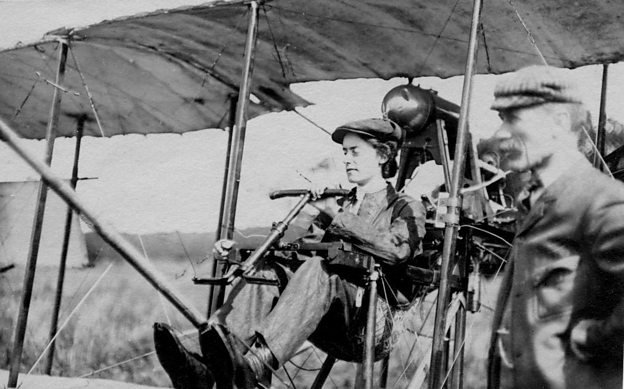Once it was finished,
You ran back, over and over, to the proof it had happened: the tracks
of her passage in the spangled grass, and then their absence –
Your footprint is missing on Earth for the span of a furlong,
as if a giant had lifted its boot and then set it down.

The poet Sinead Morrissey was inspired by the Mayfly, a creation born from a woman’s creativity, dreams, and determination. Many years later, a stainless steel sculpture of the aircraft found its place in a city park, preserving its creator’s name to this day. Lilian Bland made her mark in aviation history by designing, building, and flying the Mayfly.
Irishwoman Lilian E. Bland was the first woman in the world to design, build, and fly an aircraft. Inspired by birds in flight and a postcard featuring the Bleriot monoplane, she began her work. Her desire to fly like birds, reach the infinite, and be free led this journalist and photographer to pursue her dreams in aviation.
Bland began designing aircraft in 1909, and her aviation endeavors lasted for about two years. Her efforts and determination during this time were admirable, yet her father’s influence in persuading her to give up flying ultimately prevailed. Concerned about the risks of aviation, her family gifted her a car, prompting her to end her aviation pursuits.
During her two-year involvement in aviation, Bland initially designed and tested small biplane gliders, the equivalent of non-motorized aircraft. In 1910, she began building her full-sized biplane glider, which she named the Mayfly. Without a motor, the glider had a wingspan of 27 ft 7 in (8.4 m) and an empty weight of around 91 kg. In its first test flights, it had skids instead of wheels, resulting in gliding motions influenced by gravity. These successful unmanned glides led Bland to plan for engine installation, but first, she conducted a weight test. With the help of four police officers and a gardener, she lifted the aircraft by its wings to test if it could bear the weight of five people, and it could. Thus began her work to motorize the glider.
Eager with excitement, Lilian Bland traveled to England before her ordered engine arrived. She brought the 20-horsepower engine back to Ireland on her own by sea. The first powered flight attempts weren’t entirely smooth, but after a few trials, the aircraft reached up to 9 meters in height.
The powered aircraft flew for the first time in August 1910 and was piloted by Bland herself until early 1911. It became Ireland’s first powered biplane. It was also the first successful flight by a woman of an aircraft she had designed and built herself. With these achievements, Lilian Bland continued her flight trials and even planned improvements to the Mayfly. She went so far as to start a small business, selling powered biplanes (without engines) for £250 and gliders for £80.
Lilian Bland ended her aviation activities in exchange for a gift from her father, a Ford Model T car. She taught herself how to drive and became the first Ford agent in Northern Ireland. Considering the era, the 1910s, it’s surprising that a car could replace a passion for aviation. Yet Bland, a woman who loved dreaming and succeeding in any field, continued to break barriers. In a letter she wrote to Flight magazine, she proudly declared: “I flew!” She had flown the plane she herself designed and built. After leaving aviation to pursue new dreams, she learned to drive and proved her capability once again by becoming Ford’s first representative in Northern Ireland.



